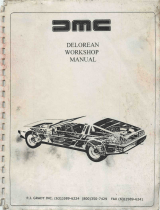Page is loading ...

Markes International Ltd
T: +44 (0)1443 230935 F: +44 (0)1443 231531 E: enquiries@markes.com
www.markes.com
QUI-1073
Version 3.0 – September 2016
User Manual
Easy-VOC™
Contents
1. Introduction ......................................................................................... 2
2. Operation ............................................................................................. 2
2.1 Leak-checking ................................................................................. 2
2.2 Taking a sample ............................................................................. 2
3. Maintenance ........................................................................................ 4
3.1 Pump inlet ....................................................................................... 4
3.2 Pump mechanism .......................................................................... 4

QUI-1073
Page 2
Markes International Ltd
T: +44 (0)1443 230935 F: +44 (0)1443 231531 E: enquiries@markes.com
www.markes.com
1. Introduction
The Easy-VOC facilitates the rapid, ‘grab-sampling’ of a small volume (<500 mL) of air/gas directly onto
sorbent tubes without the need for calibrated pumps. Using Easy-VOC also reduces risk of analyte
breakthrough, extends the application range of sorbent tubes to even more volatile compounds, and
minimises water management issues.
2. Operation
2.1 Leak-checking
The pump should be leak-tested before use to ensure the volume taken is accurate. Fit the sampling end
of a TD tube with a leak-tight cap.
Place the tube snugly, non-sampling end first, into the rubber inlet of the Easy-VOC. The tube should
seal against the rubber without tightening the pump inlet nut.
Align the red dot on the pump shaft with the 50 mL or 100 mL sample volume red dot on the
plunger. Attempt to pull the plunger back slowly. The plunger will show complete resistance to
movement if the seal is leak-tight. Any backwards motion of the plunger will indicate a leak.
2.2 Taking a sample
Place the sample tube snugly, non-sampling end first, into the rubber inlet of the Easy-VOC.
Select the sample volume required by aligning the red dot on the plunger with the pump shaft
alignment mark.

QUI-1073
Page 3
Markes International Ltd
T: +44 (0)1443 230935 F: +44 (0)1443 231531 E: enquiries@markes.com
www.markes.com
Pull the handle slowly and evenly until it latches at half-stroke or full-stroke (50 or 100 mL). This
should take approximately 5 seconds for 50 mL and 10 seconds for 100 mL.
When the flow has stopped, rotate the plunger dot away from the pump-shaft alignment, and mark a
quarter-turn either to the right (for a 100 mL sample volume) or to the left (for a 50 mL sample
volume).
For additional pump strokes, push the handle back fully without removing the tube from the pump,
then repeat the last two steps. The number of strokes taken can be recorded by rotating the counter
on the pump.

QUI-1073
Page 4
Markes International Ltd
T: +44 (0)1443 230935 F: +44 (0)1443 231531 E: enquiries@markes.com
www.markes.com
3. Maintenance
3.1 Pump inlet
The rubber pump inlet can become worn with use, resulting in leaks. Unscrew the pump inlet nut
and inspect/replace the rubber inlet. If the inlet is not replaced, inspect the inlet filter and
clean/replace as necessary.
3.2 Pump mechanism
The plunger gasket may leak if worn or not well- lubricated. To access the gasket, unscrew the pump
end fitting on the handle side, and pull the plunger out of the pump shaft.
Inspect/replace the gasket, then carefully push the plunger back into the shaft – use a fine
screwdriver or tweezers to help ease the gasket into the shaft. Lubricate the inside of the shaft with
vacuum grease to ensure a good seal.
Note: Do not over-tighten the plunger gasket.
The inlet check valve may cause leaks if worn or not well-lubricated. Unscrew the end fitting on the
inlet side and pull out the disk-shaped rubber-inlet check valve. Replace as necessary, adding a light
coat of grease around the hole. Inspect the gasket ring in the inlet end fitting, and replace if it is
damaged, before screwing the end fitting back on.
Pump inlet nut
Inlet filter
Pump rubber inlet
Gasket ring
Inlet check valve
Plunger
gasket
Pump end
fitting
Inlet end fitting
/



